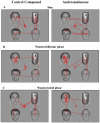Subliminally perceived odours modulate female intrasexual competition: an eye movement study
- PMID: 22383968
- PMCID: PMC3287991
- DOI: 10.1371/journal.pone.0030645
Subliminally perceived odours modulate female intrasexual competition: an eye movement study
Abstract
Background: Evidence suggests that subliminal odorants influence human perception and behavior. It has been hypothesized that the human sex-steroid derived compound 4,16-androstadien-3-one (androstadienone) functions as a human chemosignal. The most intensively studied steroid compound, androstadienone is known to be biologically relevant since it seems to convey information about male mate quality to women. It is unclear if the effects of androstadienone are menstrual cycle related.
Methodology/principal findings: In the first experiment, heterosexual women were exposed to androstadienone or a control compound and asked to view stimuli such as female faces, male faces and familiar objects while their eye movements were recorded. In the second experiment the same women were asked to rate the level of stimuli attractiveness following exposure to the study or control compound. The results indicated that women at high conception risk spent more time viewing the female than the male faces regardless of the compound administered. Women at a low conception risk exhibited a preference for female faces only following exposure to androstadienone.
Conclusions/significance: We contend that a woman's level of fertility influences her evaluation of potential competitors (e.g., faces of other women) during times critical for reproduction. Subliminally perceived odorants, such as androstadienone, might similarly enhance intrasexual competition strategies in women during fertility phases not critical for conception. These findings offer a substantial contribution to the current debate about the effects that subliminally perceived body odors might have on behavior.
Conflict of interest statement
Figures




Similar articles
-
Putative human pheromone androstadienone attunes the mind specifically to emotional information.Horm Behav. 2009 Apr;55(4):548-59. doi: 10.1016/j.yhbeh.2009.01.002. Epub 2009 Jan 20. Horm Behav. 2009. PMID: 19470369
-
Androstadienone's influence on the perception of facial and vocal attractiveness is not sex specific.Psychoneuroendocrinology. 2016 Apr;66:166-75. doi: 10.1016/j.psyneuen.2016.01.016. Epub 2016 Jan 19. Psychoneuroendocrinology. 2016. PMID: 26827295 Clinical Trial.
-
Androstadienone, a putative chemosignal of dominance, increases gaze avoidance among men with high social anxiety.Psychoneuroendocrinology. 2019 Apr;102:9-15. doi: 10.1016/j.psyneuen.2018.11.025. Epub 2018 Nov 20. Psychoneuroendocrinology. 2019. PMID: 30481725
-
Is androstadienone a human male pheromone? More research is needed.Physiol Behav. 2025 Jan 1;288:114733. doi: 10.1016/j.physbeh.2024.114733. Epub 2024 Nov 5. Physiol Behav. 2025. PMID: 39510224 Review.
-
Is androstadienone a putative human pheromone?Curr Med Chem. 2011;18(8):1213-9. doi: 10.2174/092986711795029654. Curr Med Chem. 2011. PMID: 21291365 Review.
Cited by
-
The Function of Fear Chemosignals: Preparing for Danger.Chem Senses. 2021 Jan 1;46:bjab005. doi: 10.1093/chemse/bjab005. Chem Senses. 2021. PMID: 33569586 Free PMC article.
-
Inter- and Intra-Species Communication of Emotion: Chemosignals as the Neglected Medium.Animals (Basel). 2019 Oct 31;9(11):887. doi: 10.3390/ani9110887. Animals (Basel). 2019. PMID: 31683710 Free PMC article. Review.
-
Natural environments, ancestral diets, and microbial ecology: is there a modern "paleo-deficit disorder"? Part I.J Physiol Anthropol. 2015 Jan 31;34(1):1. doi: 10.1186/s40101-015-0041-y. J Physiol Anthropol. 2015. PMID: 25636731 Free PMC article. Review.
-
Possible Use of Phytochemicals for Recovery from COVID-19-Induced Anosmia and Ageusia.Int J Mol Sci. 2021 Aug 18;22(16):8912. doi: 10.3390/ijms22168912. Int J Mol Sci. 2021. PMID: 34445619 Free PMC article. Review.
-
Chemical Fingerprints of Emotional Body Odor.Metabolites. 2020 Feb 28;10(3):84. doi: 10.3390/metabo10030084. Metabolites. 2020. PMID: 32121157 Free PMC article.
References
-
- Karlson P, Lüscher M. ‘Pheromones’: a new term for a class of biologically active substances. Nature. 1959;183:55–56. - PubMed
-
- Tirindelli R, Dibattista M, Pifferi S, Menini A. From pheromones to behavior. Physiol Rev. 2009;89:921–956. - PubMed
-
- Wysocki CJ, Preti G. Facts, fallacies, fears, and frustrations with human pheromones. Anat Rec A Discov Mol Cell Evol Biol. 2004;281:1201–1211. - PubMed
-
- Stowers L, Marton TF. What is a pheromone? Mammalian pheromones reconsidered. Neuron. 2005;46:699–702. - PubMed
-
- Hays WST. Human pheromones: have they been demonstrated? Behav Ecol Sociobiol. 2003;54:89–97.
MeSH terms
Substances
LinkOut - more resources
Full Text Sources

